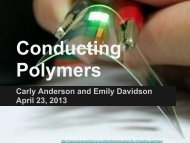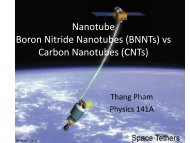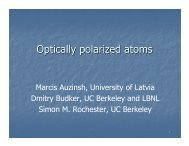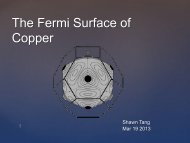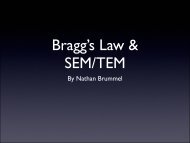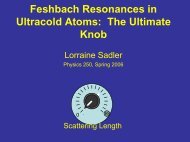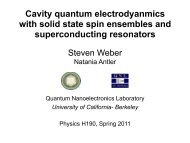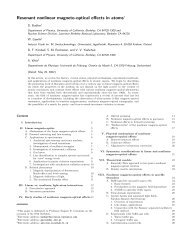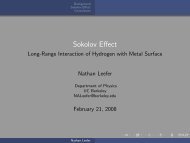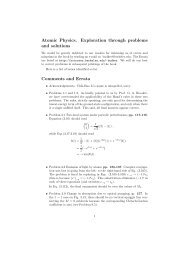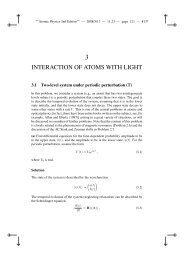Atomic Tests of Discrete Symmetries at Berkeley - The Budker Group
Atomic Tests of Discrete Symmetries at Berkeley - The Budker Group
Atomic Tests of Discrete Symmetries at Berkeley - The Budker Group
Create successful ePaper yourself
Turn your PDF publications into a flip-book with our unique Google optimized e-Paper software.
FIGURE 1. Partial level diagram <strong>of</strong> Dy showing the transitions in the current popul<strong>at</strong>ion scheme. Solid<br />
arrows indic<strong>at</strong>e excit<strong>at</strong>ion; dashed arrows indic<strong>at</strong>e spontaneous decay.<br />
th<strong>at</strong> it reverses with the sign <strong>of</strong> the residual energy separ<strong>at</strong>ion (decrossing) as described<br />
by the P-odd, T-even rot<strong>at</strong>ional invariant:<br />
dE<br />
dt · (B − B c), (1)<br />
where B c is the magnetic field required to cross the levels.<br />
Our most recent PNC search [12] was originally motiv<strong>at</strong>ed by theoretical estim<strong>at</strong>es<br />
[13] predicting a substantial enhancement due to the small energy separ<strong>at</strong>ion <strong>of</strong> the<br />
opposite-parity levels. <strong>The</strong>se estim<strong>at</strong>es had large uncertainties due to extreme complexity<br />
<strong>of</strong> the structure <strong>of</strong> the <strong>at</strong>omic st<strong>at</strong>es involved. Unfortun<strong>at</strong>ely, despite the fact th<strong>at</strong><br />
the experimental sensitivity to the PNC m<strong>at</strong>rix element (H w ) considerably exceeds other<br />
PNC experiments performed so far (see, e.g., Ref. [14] for a review), no PNC effect was<br />
detected, and an upper limit <strong>of</strong> |H w | < 5 Hz (68% C.L.) was established. This st<strong>at</strong>isticslimited<br />
experiment used pulsed lasers with repetition r<strong>at</strong>e <strong>of</strong> 10 Hz, which led to a low<br />
effective duty cycle (∼ 10 −4 ). Using cw lasers, we have developed an efficient popul<strong>at</strong>ion<br />
method <strong>of</strong> the nearly degener<strong>at</strong>e st<strong>at</strong>es [15] which will significantly improve the<br />
sensitivity <strong>of</strong> the PNC measurement (see below).<br />
<strong>The</strong> basic setup for the current PNC measurement is depicted in Fig. 2. Atoms<br />
emerge from an effusive oven source oper<strong>at</strong>ing <strong>at</strong> T ∼ 1500 K and pass through several<br />
collim<strong>at</strong>ors. <strong>The</strong>n, they enter the electric- and magnetic-field interaction region where<br />
they are excited by laser beams and end up popul<strong>at</strong>ing the odd-parity st<strong>at</strong>e B (the role <strong>of</strong><br />
the cylindrical lenses will be described below). A sinusoidally varying electric field is<br />
applied with two grids consisting <strong>of</strong> ∼ 5 × 10 −3 cm diam. Be-Cu wire. Wire grids were<br />
chosen instead <strong>of</strong> pl<strong>at</strong>es in order to minimize stray surface charge. <strong>The</strong> magnetic field



